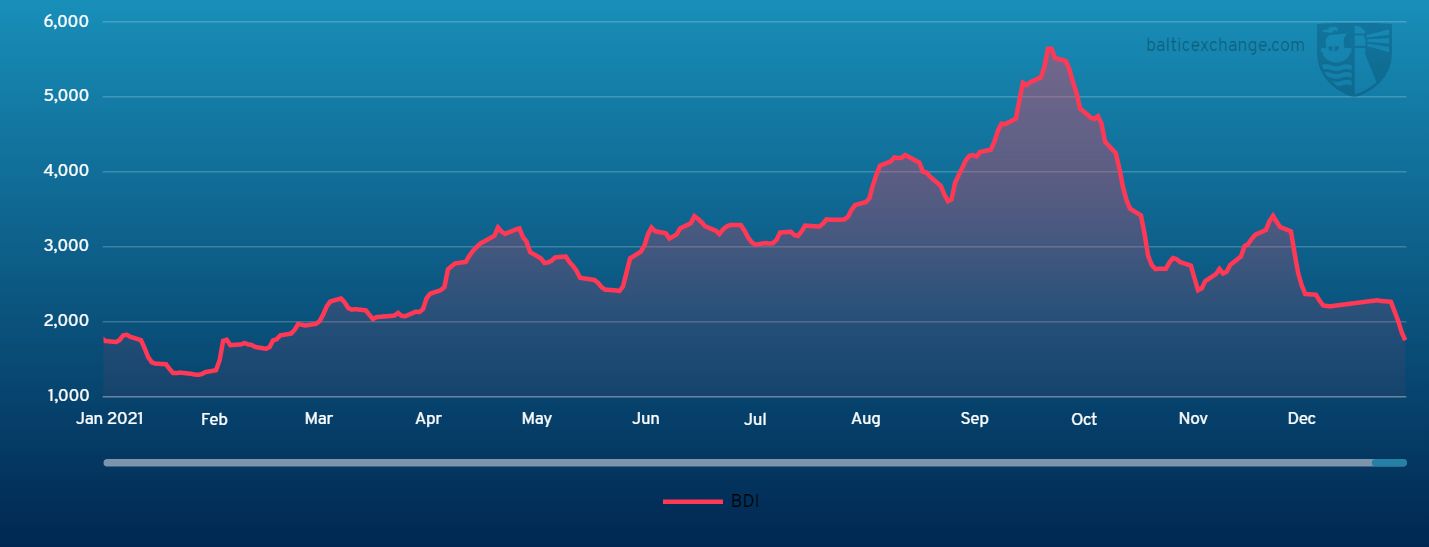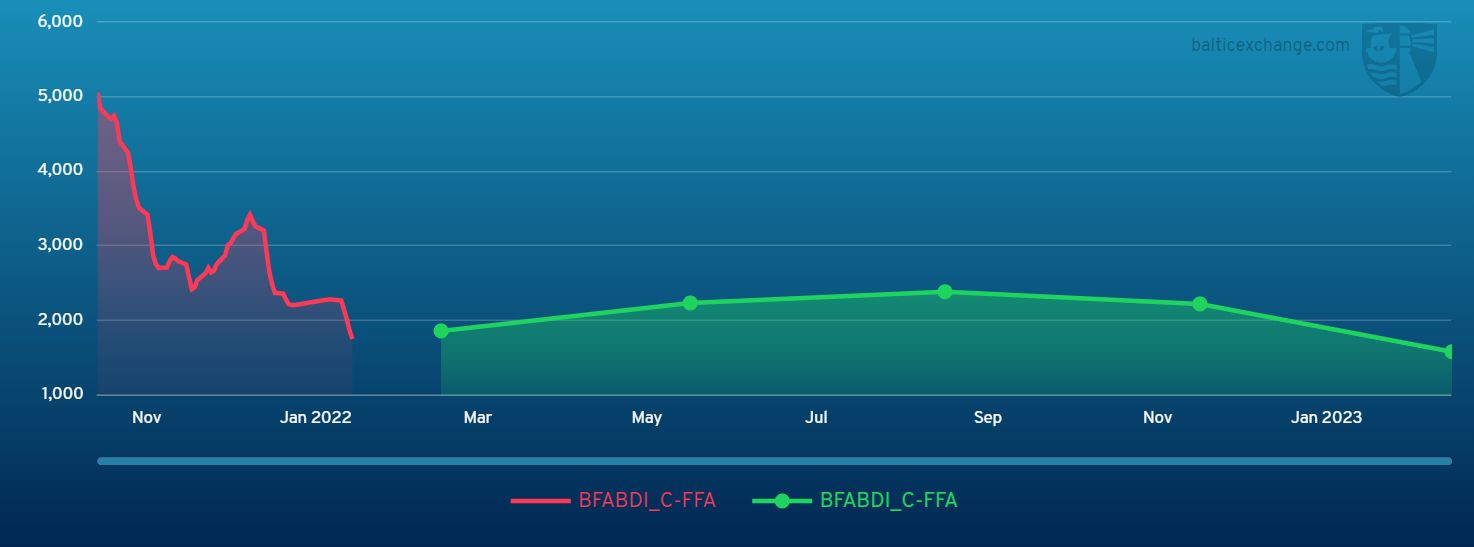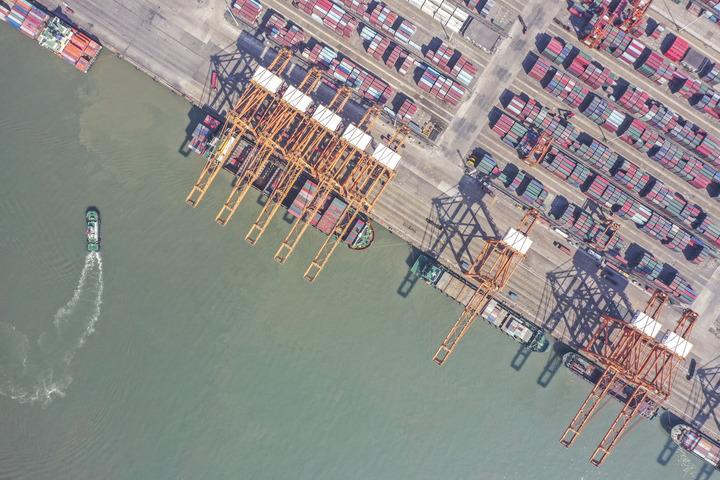BEIJING, Jan. 17 (Xinhua) -- The Baltic Exchange has published its weekly report of the dry and tanker markets for Jan. 10-14, 2022 as below:
Capesize
The Capesize market endured a somewhat traditional post-holiday Q1 drop as the 5TC descended 7,760 over the week to settle at $12,407. Trading activity was relatively quiet over the week as news from Brazil reported high rainfall affecting mining operations of iron ore flow. The Brazil to China C3 was unexpectedly softer as the route settle down to $19.175. The Backhaul C16 route from North China to Europe was one of the harder hit routes over the week seeing the route turn negative by Thursday to settle Friday at -$5,275, a negative rating implying the voyage rate received by owners for cargo isn’t enough to cover vessel expenses of the trip. The Pacific managed to maintain a more stable flow of cargo out of West Australia. But even from this region markets cargoes were underwhelming. The West Australia to Qingdao C5 closed the week at $7.014. Looking at the earnings comparison between the busier Transpacific C10 which closed down at $6,242 to the Transatlantic C8 at $19,300, possibly reflecting the tighter tonnage situation in the Atlantic that may spark the region with any solid cargo inflow.
Panamax
The decline in the Panamax market showed no signs of abating this week with further substantial corrections in both basins. In the Atlantic, a distinct lack of mineral demand in the North - as well as a build-up of tonnage count - weighed heavy on the few deals to be reported this week. An 81,000dwt agreeing to $20,500 midweek for a transatlantic round trip via US east coast. Talk midweek of a floor being found from EC South America appeared premature with Charterers able to pick off tonnage at will at times. South East Asia ballasters, notably the smaller/older units, are now undercutting the larger type vessels. A 75,000dwt delivery Singapore fixing $20,000 for a trip via EC South America back to the Far East. Asia remained downcast too, Indonesian coal exports continue to be an issue. And, despite some minor support ex Australia, this did little to dent into an ever-growing tonnage count with limited options.
Supramax / Ultramax
Another week in which sentiment remained negative overall. However, there was a change in direction from the US Gulf which saw a slight improvement in rates. Generally, there remained a lack of fresh enquiry in many areas and a solid supply of prompt tonnage availability. Limited period activity was seen but a 53,000dwt open Karachi was fixed for three to five months trading at $25,000. The only bright spark in the Atlantic was the US Gulf, a 61,000dwt fixing from here for a trip to the East Mediterranean in the low $30,000s. The Asian basin was split, whilst the lack of cargo remained in the south. Further north, there was a little support for backhaul cargoes and Pacific round business. A 57,000dwt was heard fixed for a trip from China to West Africa at around $21,000. The Indian Ocean saw a little more activity, a 52,000dwt fixing a trip from East Coast India area to China in the mid $16,000s.
Handysize
Another week of reductions on the BHSI with pressure continuing in the Atlantic basin. Numbers continue to fall on the Continent with a 32,000dwt rumoured to have fixed from Amsterdam to the US Gulf at $14,000 and a 38,000dwt open in the Baltic fixing a trip to the US Gulf at $14,000. A 36,000dwt fixed Rouen to Morocco at $13,250. In the Mediterranean a 28,000dwt was fixed for a trip from Canakkale via the Black Sea to the Western Mediterranean with an intended cargo of grains at $19,750. A 32,000dwt open in the Sea of Marmara fixed via Turkey for a trip to the Egyptian Mediterranean with an intended cargo of steels at $15,500. In Asia, a 35,000dwt open in Fangcheng was fixed for two to three laden legs at $22,000. A 32,000dwt open in the Arabian Gulf was fixed for two to three laden legs with redelivery Singapore-Japan range at $26,000.
VLCC
The first full week back has yielded little change, with the increased flat rates for this year seeing the fixing rates reduced to maintain the floor. For 280,000mt Middle East Gulf/USG (via Cape of Good Hope) the market continues to be assessed at around the WS18.5 level. Charterers have been busier this week on the 270,000mt Middle East Gulf/China route and rates have slipped less than a point to around the WS36.5 level (which shows a round trip TCE of minus $4.2k per day). In the Atlantic there has been a handful of fixtures reported, reducing tonnage availability. The rate for 260,000mt West Africa/China has improved by a point to WS38.5 (a round-trip TCE of minus $735/day). Meanwhile, the 270,000mt USG/China eased at the beginning of the week and has now started to recover, although last assessed at $4.75m (a round-trip TCE of minus $800/day), down $68k from a week ago. Interestingly, today a Frontline vessel is being reported on subjects to Exxon at $4.9m.
Suezmax
The rate for 130,000mt Nigeria/UKC has dropped 2.5 points this week to WS52.5 (a round-trip TCE of minus $1.3k/day) and 135,000mt Black Sea/Augusta remains between WS60-62.5 (a round-trip TCE of minus $5.4k/day). In the 140,000mt Basrah/West Mediterranean market ENI, Shell, Petroineos and Exxon were reported to have taken ships on subjects and the rate has improved 7.5 points to just shy of WS33.
Aframax
The 80,000mt Ceyhan/Mediterranean market recovered some of the recent drop off, rising 15 points to WS97.5 level (a TCE of $6.6k/day). In Northern Europe, rates for 80,000mt Hound Point/UKC slipped three points to a fraction below WS95 (corresponding to a round-trip TCE of $minus $2.6k/day) and 100,000mt Baltic/UKC rates have again fallen 10 points to between WS102.5 and WS105 (a TCE of $20.1k/day), with Ice-Class vessels still required in the Baltic region.
Across the Atlantic the peak in rates was reached early on and are now gradually sliding back down. 70,000mt US Gulf/UK Continent is down 5.5 points to between 97.5-100 (a round-trip TCE of $5.7k/day). In the local markets, the 70,000mt Covenas/US Gulf trip is assessed 3.5 points lower than a week ago at just under WS95 ($890/day round-tip TCE) and 70,000mt EC Mexico/US Gulf rates remain static at WS100 ($4k/day round-trip TCE).
Clean
The CPP tanker market has been tested down again this week for the most part, there have however been a couple of exceptions that have seen some improvement. In the Middle East Gulf the LR2s of TC1 currently sit at WS89.29 (-WS9.42) a round trip TCE of $2129/day and the most affected this week. The LR1s have been steadfast by comparison and TC5 55k Middle East Gulf / Japan is down 0.96 points to WS97.64 a round-trip TCE of $2407/day. On TC8 the market looks to have settled at $25Pmt ($1.625m) for the moment.
In the Mediterranean the Handymax rates have again been whittled away and TC6 30kt Skikda / Lavera has come off WS10 to WS 170.63. The LR2s, TC15 80k Mediterranean / Japan has again fallen at the hands of soft sentiment and currently sits around the $1.85m mark. The Baltic Handymax held on until the end of the week before finally dropping and TC9 30k Baltic / UK-Continent is now at WS191.79 (-WS8.21). On the UK-Continent, MR activity has been relatively steady this week - although unfortunately not enough for freight rates to hold at previous levels. TC2 37k UK-Continent / US Atlantic Coast is currently marked at WS137.22 (-WS9.17) and TC19 37k Amsterdam to Lagos has seen a similar dip of 8.93 points to WS141.43 (a round trip TCE of $7661/day). On LR1s, TC16 60k Amsterdam / Offshore Lomé has been relatively inactive on the face of things, subsequently dropping another 4.08 points to WS100.71. In the Americas both runs have seen a welcome upturn off the back of improved activity this week. TC14 38k US Gulf / UK-Continent is now WS 89.29 (+WS4.65) and TC18 38k from US Gulf / Brazil WS 145.71 (+WS13.21)
Headquartered in London and a subsidiary of the Singapore Exchange (SGX), the Baltic Exchange publishes a range of indices and assessments which provide an accurate and independent benchmark of the cost of transporting commodities and goods by sea. These include the Baltic Dry Index (BDI), the dry bulk shipping industry's best known indicator. Published daily since 1985, this provides a snapshot of the daily spot market earnings of capesize, panamax and supramax vessel types on the world's key trading routes.

Chart shows Baltic Dry Index (BDI) during Jan.14, 2021 to Jan.14, 2022

Baltic Forward Assessment for BDI
In March 2018 the BDI was re-weighted and is published using the following ratios of time charter assessments: 40 percent capesize, 30 percent panamax and 30 percent supramax. The information is provided by a panel of international shipbrokers.
(Source: The Baltic Exchange, edited by Niu Huizhe with Xinhua Silk Road, niuhuizhe@xinhua.org)




 A single purchase
A single purchase









